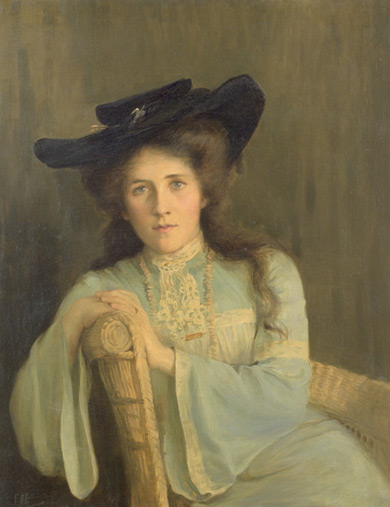Deborah Vernon Hackett
Hackett poses with one hand folded neatly under the other, bringing our attention to the delicate wedding ring on her left finger. This detail is especially significant in a portrait most likely commissioned by her husband as a 21st birthday gift.
Who directs the pose in a portrait - the artist or the subject?
Leaning casually over the arm of the wicker chair, Hackett’s pose creates an air of informality. Her expression, however, reveals the polite restraint of a woman who might rather be somewhere else.
Look closely at Hackett’s pose and expression.
What does her body language and expression tell you about her character?
Hackett’s wide-brimmed hat and pastel blue lingerie dress accurately reflect the fashions of the early 1900s. At this time, the hat, like the wedding ring, was an important status symbol for women in ‘respectable’ society.
How does the artist use dress to represent Hackett’s social status and wealth?
Fuller uses colour to create a certain atmosphere in her portrait of Hackett.
Describe the colours in Fuller’s portrait.
What kind of atmosphere has the artist created?
In the early 20th century, artists focussed on capturing a subject’s character through pose and expression. In her portrait of Hackett, you see Fuller has removed all detail from the background in order to concentrate attention on the individual.
If you could add your own background to the portrait, what would it be?
Move your mouse over the portrait to
see the points of interest.
About the artist
Florence Ada Fuller was born in South Africa in 1867. She arrived in Melbourne as a young girl and worked as a governess before studying painting at the National Gallery School.
At the age of 20, Fuller opened her own studio where she worked on her painting and taught art classes. She became well-regarded for her portraits and exhibited widely in Australia and overseas.
Fuller painted Hackett’s portrait after spending ten years abroad in France, England and South Africa. She returned to Perth in 1904, where she worked for another five years before resettling in Sydney.


